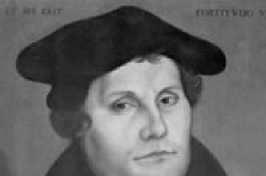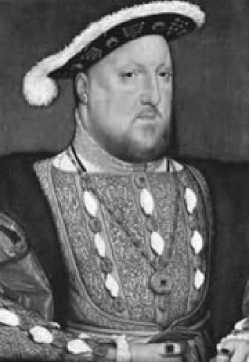
In order to fully understand American history one must have a grasp of the role that religion has played in the development of this nation. In fact, the history of religion in the Western world going back hundreds of years before the discovery of America has affected this nation down to the present time.
Martin Luthar
In the early 1500s, Martin Luther became scandalized by the degree of corruption he observed in the Christian Church. Today we refer to the church to which Luther first belonged as the Roman Catholic Church; at that time it was the only church that existed in the Western world, although Catholicism varied in certain ways from country to country. For all kinds of reasons stemming the from the church having wielded extraordinary social and political pressure over the Western world for more than a thousand years, the corruption touched the lives of many people.
Luther was an extremely pious and devout priest, so much so that even on the day of his ordination, he was not confident that he was holy enough to be able to conduct his first mass. It is understandable that a man with serious concerns about his own holiness would be shocked to discover corruption in an institution he revered. What bothered him more than anything was the sale of indulgences, by which priests could forgive sins in exchange for donations of money.
Luther began to collect his complaints and finally delivered them in the form of ninety-five theses that he nailed on the door of the cathedral in Wittenberg, Germany. To say that his complaints were timely doesn't quite capture the impact; within one generation of Martin Luther's protest, Protestantism, consisting of a number of Christian sects that had rebelled against the leadership of the Roman church, had spread over much of northern Europe. As frequently happens in cases of revolution, after the initial upheaval was complete, the rebellion fragmented further into various segments. Thus the Protestant Reformation led to the creation of a variety of churches: Lutheran, Baptist, Methodist, Calvinist, and many other varieties. (More than one hundred different Protestant denominations exist in America today.)
Most interesting for American history is the fact that during the time when the Reformation in Germany was getting underway, a young English prince fell in love with his brother's widow. Henry and Arthur were the sons of Henry VII, the first of the Tudor monarchs. Under a treaty negotiated by Henry VII in 1496, Prince Arthur was betrothed to Catherine of Aragon, daughter of Ferdinand of Aragon and Isabella of Castile.8 Arthur and Catherine were finally married in 1501, but soon after the marriage Arthur fell ill and died of tuberculosis. As he was only 15, it was claimed that his marriage to Catherine was never consummated, a claim which the widow supported.
Young Prince Henry, now heir to the Tudor throne, was in love with Kathryn and wished to marry her. At that time, however, it was considered incest for a man to marry his brother's widow, so Henry appealed to the Rome to nullify the marriage between Arthur and Catherine so that he would be free to marry her, on the grounds that Catherine's marriage to
Arthur was unconsummated. Pope Julius II, nervous over the fragmentation of his religious domain, was happy to grant an annulment to keep himself in good favor with the English monarch.
Upon the death of Henry VII, the prince became King Henry VIII, and his wife Queen Catherine. The story of Henry and his six wives is well known. Not so well known is the fact that several years into his reign Henry argued forcefully against the reforms of Martin Luther and defended the Roman Catholic Church from what he saw as false accusations. In recognition of his faithful service, Pope Leo X named Henry."Defender of the Faith," a title borne by British monarchs to this day.

King Henry VIII
The story does not end there, of course. After twenty years of marriage to Catherine of Aragon, with no male heir to show for it, Henry became disenchanted with his wife. At the same time he was becoming attracted to a handsome young woman of the court, Anne Boleyn. The story of Henry's infatuation with Anne is less important than the fact that eventually he sought an annulment of his marriage to Catherine on the grounds that the original annulment enabling the union had gone against the will of God. He claimed to believe that the reason he had no male heirs was God's displeasure with the marriage.
Now the pope—Pope Clement VI—was in a difficult position; he was being asked to declare that the daughter of two powerful Catholic monarchs of the kingdom of Spain had been living in sin with the English king for some time, and that their child, a girl named Mary, was a bastard. In addition, Catherine's nephew was Holy Roman Emperor Charles V, supporter of the pope, who would also have been outraged by the annulment. Undoubtedly aware of the political implications of his ruling, Pope Clement denied Henry's request.
Infuriated and infatuated, Henry decided to break with Rome, and thus came about the English Reformation, so-called because Henry made himself head of the Church of England, which became known as the Anglican Church. Although the Anglican Church had formally severed its ties with Rome, the Anglican faith kept many of the trappings of the Roman Catholic religion, including the hierarchy of bishops. The Latin liturgy, however, was dropped in favor of English.
Because the church in Rome was a political as well as a religious force, and because the idea of the separation of church and state was not yet developed, Henry's break with Rome led to conflicts between those in England who clung to the Catholic faith and those who adopted Protestantism. The conflict existed even among Henry's closest advisors, a number of whom were executed for their resistance to the King's will.9 Henry's daughter Mary, whose Spanish family remained staunch Catholics, kept to the Roman religion herself. Because tradition held that only sons could accede to the monarchy, Henry's son Edward, daughter of Henry and his third wife, Jane Seymour, succeeded upon Henry's death, even though he was younger than his half sisters Mary and Elizabeth.
Diamond, Guns, Germs and Steel: The
-the family
Edward VI became king at age nine and never reached majority. Toward the end of his reign, as his health deteriorated, the question of his successor was a source of considerable conflict. Mary Tudor, daughter of Henry and Catherine and still a strong Catholic, had a claim to the throne which was supported by the Catholic monarchs of Spain and France and her nephew, Holy Roman Emperor Charles V. The Pope naturally desired to see Catholicism restored to England as a bulwark against the further spread of Protestantism.
Factions in England who wanted to see the Protestant religion continued advanced other claimants to the throne, including Lady Jane Grey, granddaughter of Henry VIII's sister Mary. The events surrounding Edward's demise are clouded with mystery, but his death was concealed for a time in order to install Jane Grey, a Protestant who was barely seventeen years old, on the throne in order to block the accession of Mary. Lady Jane's supporters planned to have Mary arrested and placed in the Tower of London, but Mary got wind of the plot and foiled it. Nine days into Lady Jane's reign, Mary became the monarch with a great deal of popular support among the English people. Lady Jane was imprisoned and later executed, as were many of her supporters, on charges of treason, even though Queen Mary had promised clemency to young Queen Jane.
Queen Mary, who became known as "Bloody Mary," ordered many imprisoned Catholics to be released and had a number of Protestants opponents executed, since practicing the wrong faith was considered treason. In hopes of having an heir to thwart the accession of
Her Protestant sister Elizabeth, Mary married Prince Philip of Spain, who eventually became King Philip II. Because of long-standing animosity between England and Spain, Mary's marriage was very unpopular with the people. She never had a child.

Elizabeth I, "The Great"
Upon Mary's death, Henry's daughter Elizabeth became Queen according to the Act of Succession of 1544. The issue of Elizabeth's potential marriage had enormous political import and dominated the first decades of her reign. The matter of a suitable husband was heavily debated among Elizabeth's councilors. The fact that many of her suitors were Catholics made the search for a possible husband politically explosive. Elizabeth remained, however, the "Virgin Queen" and never married. When it became apparent that she would not have an heir, the issue of succession again became critical. One claimant to the throne was Elizabeth's first cousin, Mary Queen of Scots, but the fact that she was Catholic led to Elizabeth's having her executed.
The struggle between Catholics and Protestants left a long and bloody trail through English and European history. Heretics10—those who professed the wrong faith—were burned at the stake, and the number of executions on religious grounds can only be estimated. The Thirty Years' War, 1618-1648, one of the bloodiest and most brutal in European history, was but one of many conflicts with religious overtones. The horrors of the Spanish Inquisition, the burning of witches, and depredations against Jews and others whose faith was in question are all part of the long and violent history of religious conflict in the western world. Lingering animosities have persisted into modern times,
10 The word "heretic" comes from a Greek root meaning to choose.
28
As evidenced by the violent conflicts between Catholics and Protestants in Ireland throughout much of the 20th century.10




 World History
World History









